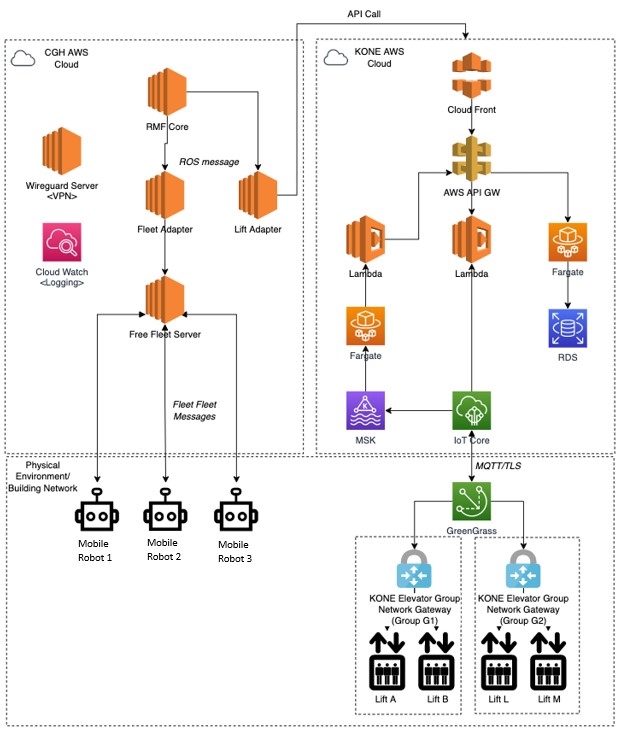Challenge: Integration of robotics in buildings' lifts
Overview:
The ability for robots to travel autonomously and access various floors in a multi-storey building through lifts will create new opportunities to leverage robotic technologies to augment manpower and enhance efficiencies in various industry settings including healthcare. In healthcare settings, this will complement the care team's work to make healthcare more humanised.
Changi General Hospital's Centre for Healthcare Assistive and Robotics Technology (CGH-CHART), elevator company KONE, and the Smart Urban Co-Innovation Lab, are working with key industry players to facilitate this communication of multiple robots with a common bank of lifts without human intervention through the Robotic Middleware Framework (RMF), a local innovation initiative driven by CGH-CHART. Robots could be more cost effective and optimally deployed if multiple repeated integration efforts between each robot model and the common lift are not required. An earlier collaboration between CGH-CHART and KONE has yielded a solution that could be hosted in the Amazon Web Services (AWS) cloud, allowing robots to traverse different floors using existing common lifts alongside with humans and other robots. The Lab's facilitation in the test-bedding at the Galen, aims to expand the application of this initiative to multiple robot models and lifts.
Problem:
Existing robots are unable to traverse multiple floors without manual human intervention or the use of robot-dedicated lifts. This creates an infrastructure challenge as there is limited space for robot-dedicated lifts in any building, and also constrains the accessibility, mobility, and multi-tasking effectiveness of any robotic fleet, especially as building owners continue to scale up technologies and robotic fleets for various purposes.
Approach:
Going beyond healthcare settings, CGH-CHART, KONE and the Smart Urban Co-Innovation Lab have collaborated with the support of AWS, to facilitate the testbedding at CapitaLand's Galen building, where a single building could be serviced by multifunctional robots without an increase in infrastructure investment. KONE modernised Galen's passenger lifts with KONE's new generation DX Class lifts. Their lifts can communicate with robots via their open Application Programming Interfaces (APIs), allowing autonomous mobile robots to traverse across different levels in a multi-storey building. The solution that enabled this multiple robot-lift integration leverages the RMF that CGH-CHART developed locally with consortium partners. In the early phase of integration, CGH-CHART brought their robots to integrate with KONE's lift at the Galen and establish communication between their robots and KONE's lift.
To speed up the progress, CGH and KONE utilised different services from AWS's broad set of products to make available developed solutions to be rapidly deployed in the robotic environment. Services such as Amazon Elastic Compute Cloud, which delivers secure and scalable compute capacity as well as server-less services such as Lambda , Fargate, AWS API Gateway and IoT Core were used to power the communication between the different robotic fleets in an optimum and scalable fashion.
The Galen offers a live and secure environment to test robot-elevator integration for CGH-CHART robots, as well as other robotic companies' for different industry domains and applications.
Next Steps:
To go beyond healthcare use cases, CGH-CHART, KONE, and the Lab will trial the developed solution with various robotic companies' robots, where minimum integration by the robotic companies is required and the KONE lifts can be called at any time. In addition to robot-lift integration, the three parties will conduct pilot trials on robotic multi-functionality, mobility, and accessibility at the Galen testbed. Robots of different functions and applications, such as for cleaning, security, delivery, and concierge purposes, will stretch their potential in these trials. These pilot trials aim to scale up and ultimately promote the developed national standards for data exchanges between robots, lifts and automated doorways (formally called Technical Reference 93), enabling efficient autonomous operations and seamless co-existence between robots and human passengers.
Please refer to the following links for more information on the collaboration:
Changi General Hospital, CapitaLand Investment and KONE collaborate to advance the integration of robotics in buildings
Enabling robotics in how we work, live & play
Supporting Artifacts:
A) System Architecture

B) Visual storyboard of possible robot-lift integration solution outcomes
As part of the solution design process, the visual storyboard below depicts what the robot-lift integration solution could accomplish.
Disclaimer: Storyboard may not reflect current state of project

(*RMF – Robotic Middleware Framework, developed by CGH-CHART and consortium to enable interoperability of heterogeneous fleets of robots, building infrastructure, devices (IoT and IT) and systems)